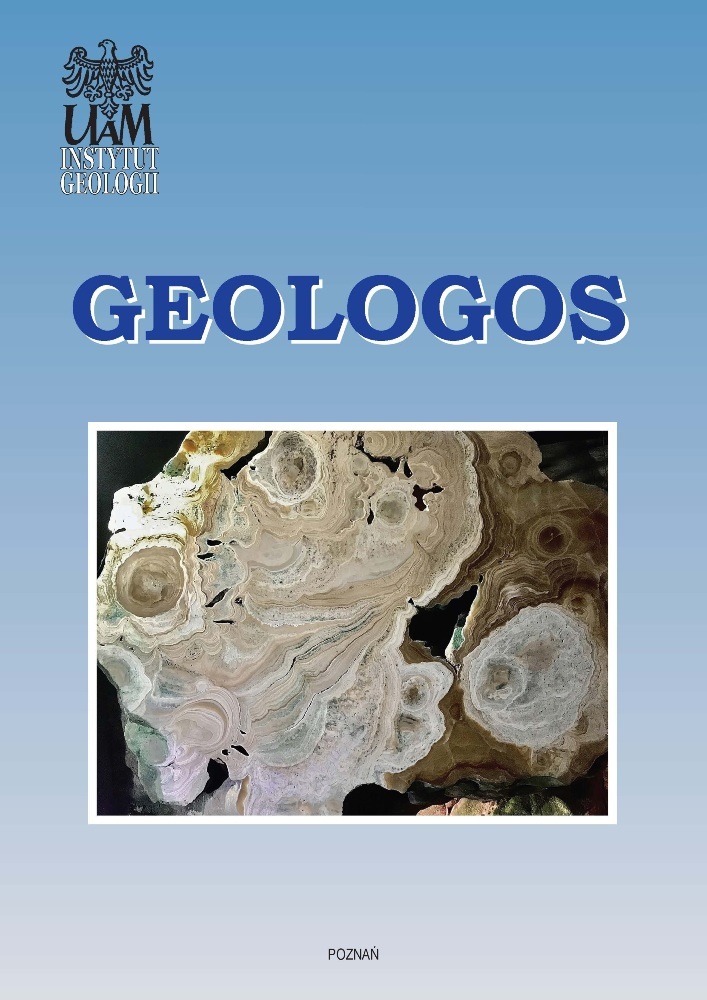Abstract
Modern hydrogeological research uses numerical modelling, which is most often based on the finite difference method (FDM) or finite element method (FEM). The present paper discusses an example of application of the less frequently used FEM for simulating groundwater circulation in the vicinity of the intake at Świniarsko near Nowy Sącz. The research area is bordered by rivers and watersheds, and within it, two well-connected aquifers occur (Quaternary gravelly-sandy sediments and Paleogene cracked flysch rocks). The area was discretized using a Triangle generator, taking into account assumptions about the nature and density of the mesh. Rivers, wells, an irrigation ditch and infiltration of precipitation were projected onto boundary conditions. Conditions of groundwater circulation in the aquifer have been assessed based on a calibrated model, using water balance and a groundwater level contour map with flow path lines. Application of the program based on FEM, using smooth local densification of the discretization mesh, has allowed for precise mapping of the location of objects that significantly shape water circulation.
References
Dąbrowski, S., Kapuściński, J., Nowicki, K., Przybyłek, J. & Szczepański, A., 2011. Metodyka modelowania matematycznego w badaniach i obliczeniach hydrogeologicznych – poradnik [Methodology of mathematical modeling in hydrogeological research and calculations – guide]. Ministerstwo Środowiska, Poznań.
Diersch, H-J., 2014. FEFLOW Finite Element Modeling of Flow, Mass and Heat Transport in Porous and Fractured Media. Springer, Berlin. 996 pp.
Dmochowska, H. [Ed.], 2016. Mały rocznik statystyczny [Concise statistical yearbook of Poland]. GUS, Warszawa. 539 pp.
Duda, R., Winid, B., Zdechlik, R. & Stępień, M., 2013. Metodyka wyboru optymalnej metody wyznaczania zasięgu stref ochronnych ujęć zwykłych wód podziemnych z uwzględnieniem warunków hydrogeologicznych obszaru RZGW w Krakowie [Methodology of selecting the optimal method of the wellhead protection area delineation taking into account the hydrogeological conditions in areas administered by the RZGW in Kraków]. AGH, Kraków. 154 pp.
Gryczko-Gostyńska, A. & Olędzka, D., 2009. Nowy Sącz. [In:] Z. Nowicki (Ed.): Wody podziemne miast Polski. Miasta powyżej 50 000 mieszkańców [Groundwater of Polish cities. Cities with more than 50,000 inhabitants]. Informator Państwowej Służby Hydrogeologicznej, PIG, Warszawa, 259–274.
Haładus, A., Zdechlik, R., Szczepański, A., Bukowski, P. & Wojtal, G., 2017. Evaluation of exploitable resources of water intakes located between rivers, based on numerical modeling, on the example of Tarnów region in Poland. [In:] 17th International Multidisciplinary Scientific GeoConference (SGEM 2017). Conference Proceedings 17, 12, 297–304.
Jaskulska, A., 2018. Ocena warunków krążenia wód podziemnych w obszarze zasilania ujęcia, w oparciu o badania modelowe metodą elementów skończonych [Evaluation of groundwater flow conditions in the recharge area of the in-take, based on model tests using finite elements method]. AGH, Kraków.
Juśko, K., Motyka, J., d’Obyrn, K. & Adamczyk, Z., 2018. Construction of a numerical groundwater flow model in areas of intense mine drainage, as exemplified by the Olkusz Zinc and Lead Ore Mining Area in southwest Poland. Geologos 24, 237–244.
Kulma, R. & Zdechlik, R., 2009. Modelowanie procesów filtracji [Groundwater modeling]. AGH, Kraków. 150 pp.
Luo, J., Wang, F., Tomsu, Ch., Druzynski, A. & Monninkhoff, B., 2014. FEFLOW-model for mine dewatering and mine water management close to groundwater systems of varying salinity, Pilbara, Western Australia. 12th IMWA Congress, Xuzhou, China.
Mikołajków, J. & Sadurski, A. (Eds), 2017. Informator PSH Główne Zbiorniki Wód Podziemnych w Polsce [PHS Communicant: Major Groundwater Reservoirs in Poland]. PIG-PIB, Warszawa. 413 pp.
Morański, W., 2016. Potencjał i ochrona zasobów ujęcia wód podziemnych w Świniarsku z wykorzystaniem modelowania numerycznego [Potential and protection of groundwater resources intake in Swiniarsko using numerical modeling]. AGH, Kraków.
Oszczypko, N., Chowaniec, J. & Koncewicz, A., 1981. Wodonośność piaskowców magurskich w świetle badań wodochłonności [Water-pressure tests of the Magura sandstones]. Annales Societatis Geologorum Poloniae - Rocznik Polskiego Towarzystwa Geologicznego 51, 273–302.
Oszczypko, N. & Wójcik, A., 1993. Objaśnienia do Szczegółowej Mapy Geologicznej Polski w skali 1:50 000, ark. Nowy Sącz [Explanations for the Detailed Geological Map of Poland, scale 1:50 000, Nowy Sącz sheet]. PIG, Warszawa.
Pietrucin, D. & Czop, M., 2015. Modelling of chemical migration under the overlapping impact of multiple and diverse pollution sources in the area of the “Zachem” Chemical Plant (Bydgoszcz, northern Poland). Bulletin of Geography. Physical Geography Series 9, 31–38.
Sinton, P., Wingle, B. & Bartlett, D., 2015. FEFLOW Model of a Copper Mine, Arizona, USA. FEFLOW Conference, Berlin, Germany.
Treichel, W., Haładus, A. & Zdechlik, R., 2015. Simulation and optimization of groundwater exploitation for the water supply of Tarnów agglomeration (southern Poland). Bulletin of Geography. Physical Geography Series 9, 21–29.
Zdechlik, R, 2016. A review of applications for numerical groundwater flow modeling. [In:] 16th International Multidisciplinary Scientific GeoConference (SGEM 2016). Conference Proceedings 3, 11–18.
Zdechlik, R. & Morański, W., 2017. Ocena zasobów ujęcia wód podziemnych w Świniarsku k. Nowego Sącza z wykorzystaniem modelowania numerycznego [Assessment of groundwater resources of the Świniarsko (near Nowy Sącz) intake based on numerical modeling]. Przegląd Geologiczny 65, 1411–1415.
Zdechlik, R.& Partyka, M., 2018. Modelowanie przepływu wód podziemnych metodami różnic skończonych i elementów skończonych – porównawcze badania poligonowe [Groundwater flow modelling using the finite differences method and the finite elements method – comparative model studies]. Biuletyn Państwowego Instytutu Geologicznego 471, 201–208.
License
Copyright (c) 2019 Robert Zdechlik, Agnieszka Kałuża

This work is licensed under a Creative Commons Attribution-NonCommercial-NoDerivatives 3.0 Unported License.
